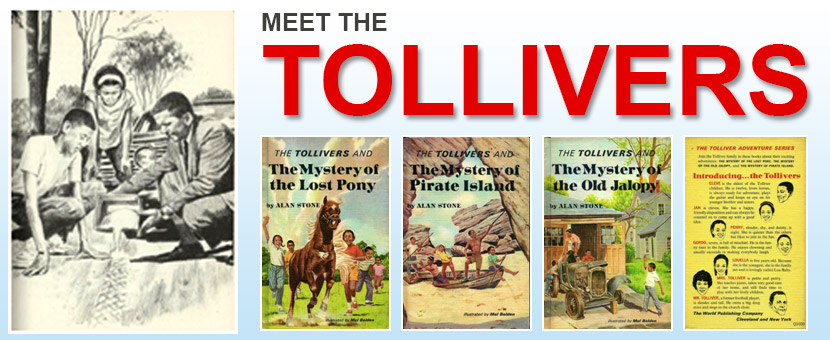In 1967, Happy Hollisters’ author Andrew Svenson (also known as “Jerry West”) introduced The Tolliver Adventure Series using a new pseudonym, Alan Stone. This series of three books, published by the World Publishing Company of Cleveland, would be the first mystery/adventure series developed for African-American children.
The Tolliver family is remarkably similar to the Hollister family, also with five children: Cleve, Jan, Penny, Gordo, and Louella. Even their dispositions and general descriptions are nearly interchangeable with the Hollisters. The two oldest Tollivers, Cleve and Jan, mirror Pete and Pam with their athleticism and cheerful dispositions. Penny, although similar in age to tomboy Holly Hollister, is dainty and quiet. Gordo, just like freckle-faced Ricky Hollister, is described as having “two wooden legs” (a very healthy appetite) and an uncanny ability to find or cause mischief wherever he goes. The baby of the Tolliver family, Louella, can be counted on to provide humorous moments with her mispronunciations and malapropisms, just like Sue Hollister.
Mr. Tolliver, a handsome former football player, owns a large drugstore, while pretty Mrs. Tolliver is a piano teacher. Like John and Elaine Hollister, they stay mostly in the background of the stories but are always ready to assist their children in solving their mysteries. The family lives in Claremont, described as a small town on the east coast, not far from the ocean.
The books were illustrated by artist Mel Bolden, who was known as the “dean of African-American illustrators.” (https://www.fireengineering.com/2014/03/10/301917/1977-fe-centennial-covers/#gref) His cover art and interior illustrations for the series opened up the marketing appeal to a new audience. The charcoal illustrations have a more somber depth and grace, completely different feel than the light-hearted, cheerful, and colorful Happy Hollisters illustrations by Helen S. Hamilton.
The Tolliver Adventure Series included three titles: The Mystery of the Lost Pony; The Mystery at Pirate Island; and The Mystery of the Old Jalopy. With just 12 chapters and about 130 pages, however, the Tolliver stories are slightly shorter than Happy Hollister books. Another interesting departure from the traditional Happy Hollisters model is that each book leads directly into and introduces the next volume by name. Heavy on energetic dialog, punctuated with “gol-lee” and “zowie,” the stories feel very much like any of the Happy Hollisters books and could be easily interchanged. After Svenson’s death, The Tolliver stories were, in fact, reworked into Bobbsey Twins books with similar names: The Secret in the Pirate’s Cave; The Dune Buggy Mystery; and The Missing Pony Mystery.
The Tolliver books are not easy to come by, but if you happen upon one in a used book or antique store, you’ll be rewarded with a fun mystery and an excellent memento of late 1960s publishing.

